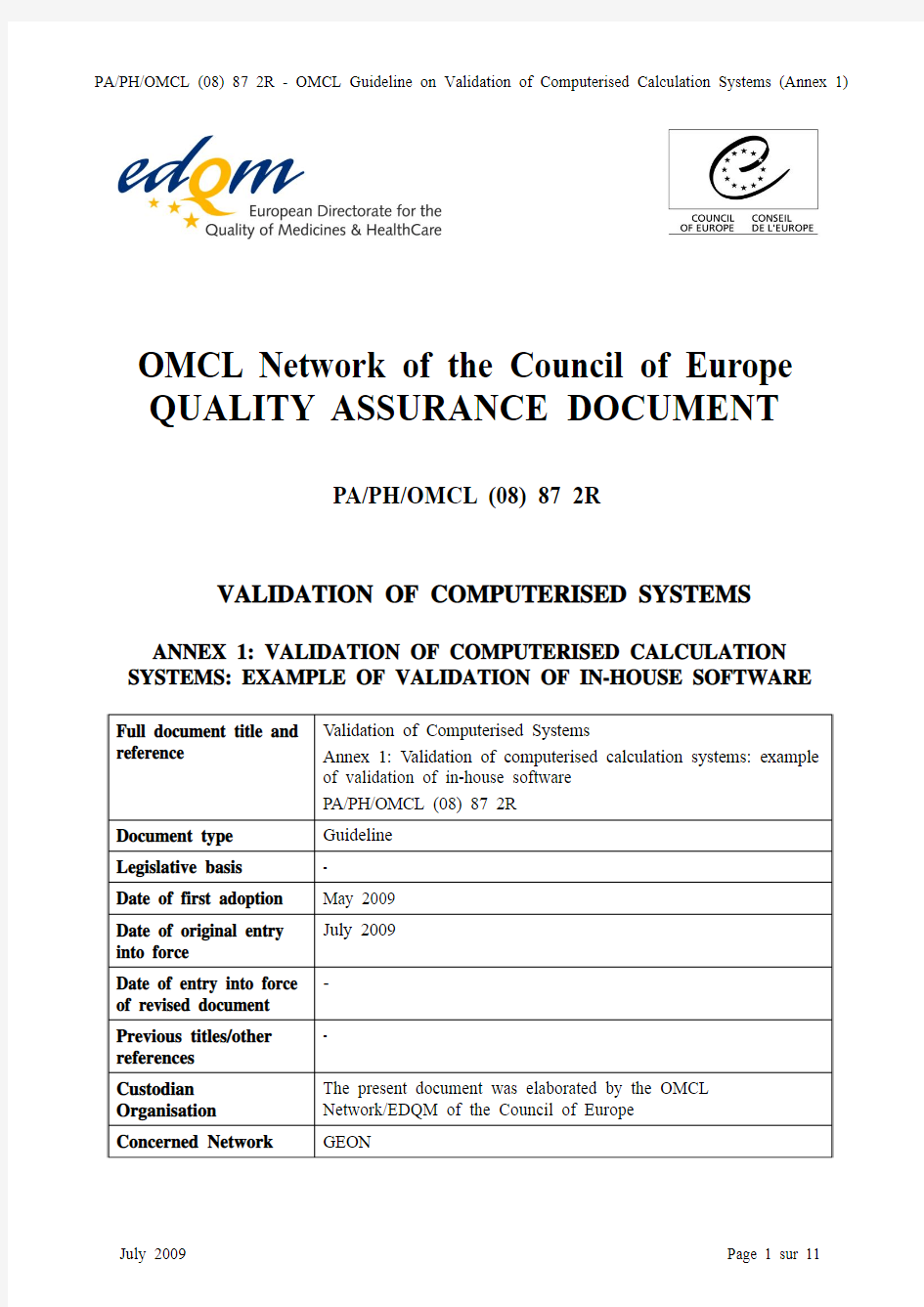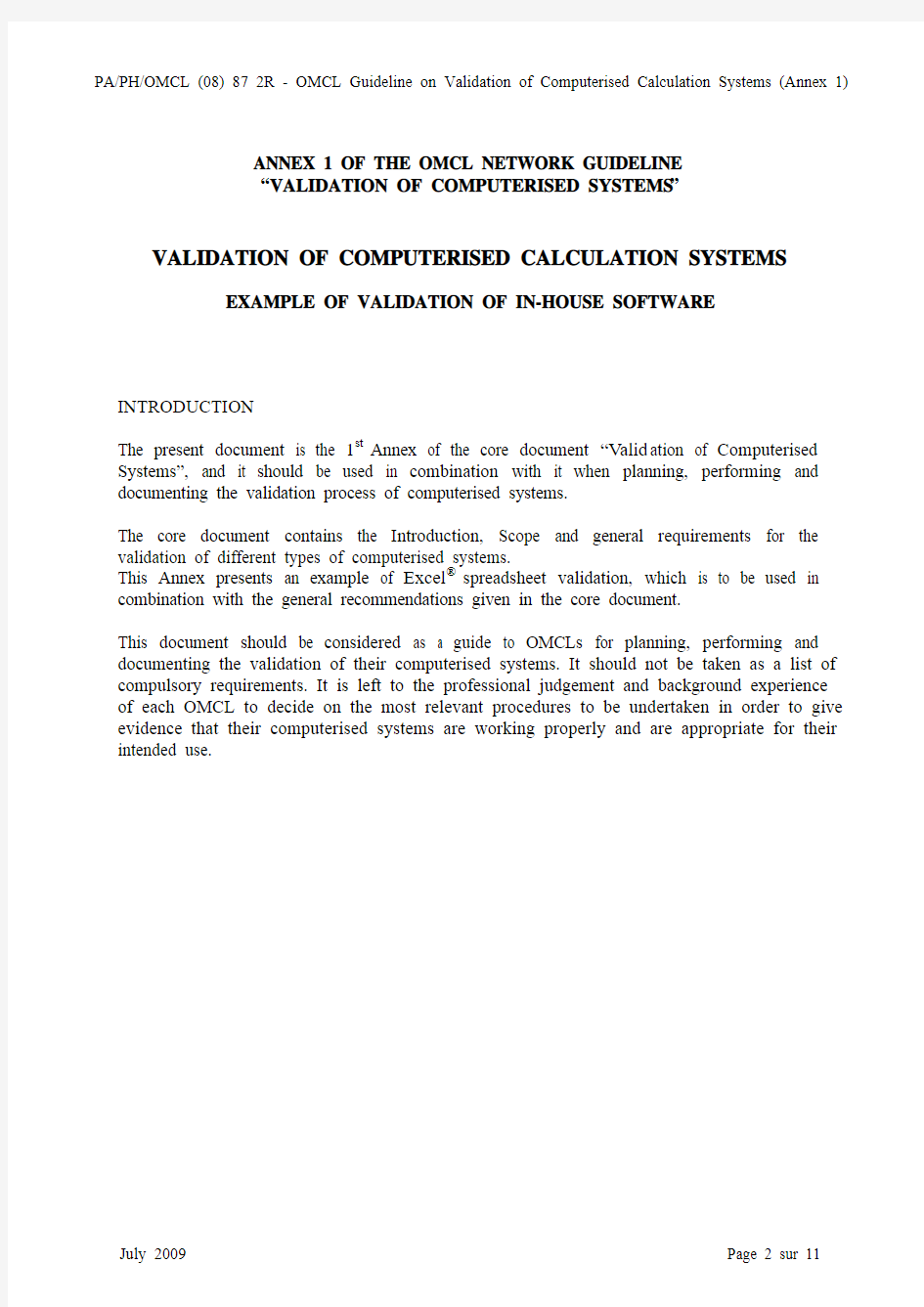

OMCL Network of the Council of Europe QUALITY ASSURANCE DOCUMENT
PA/PH/OMCL (08) 87 2R
VALIDATION OF COMPUTERISED SYSTEMS ANNEX 1: VALIDATION OF COMPUTERISED CALCULATION SYSTEMS: EXAMPLE OF VALIDATION OF IN-HOUSE SOFTWARE
ANNEX 1 OF THE OMCL NETWORK GUIDELINE
“VALIDATION OF COMPUTERISED SYSTEMS”
VALIDATION OF COMPUTERISED CALCULATION SYSTEMS EXAMPLE OF VALIDATION OF IN-HOUSE SOFTWARE
INTRODUCTION
The present document is the 1st Annex of the core document “Valid ation of Computerised Systems”, and it should be used in combination with it when planning, performing and documenting the validation process of computerised systems.
The core document contains the Introduction, Scope and general requirements for the validation of different types of computerised systems.
This Annex presents an example of Excel?spreadsheet validation, which is to be used in combination with the general recommendations given in the core document.
This document should be considered as a guide to OMCLs for planning, performing and documenting the validation of their computerised systems. It should not be taken as a list of compulsory requirements. It is left to the professional judgement and background experience of each OMCL to decide on the most relevant procedures to be undertaken in order to give evidence that their computerised systems are working properly and are appropriate for their intended use.
1. SOFTWARE PRESENTATION AND GENERAL INFORMATION
This software’s aim is to calcula te a vaccine titration (Figure 1). From results obtained for a reference product (height measured at 4 concentrations), a calibration curve and its formula are provided. Both of them are needed to calculate the concentrations corresponding to the height measured for the tested vaccine.
In Figure 1, grey cells are filled with numerical data from experimentation and are the only ones that can be changed by the operator. All cells including formula are locked. No more than one cell from the calibration range can be empty; all cells for vaccines must be filled to guarantee proper use.
To access the software, a password is needed to log on the computer.
Back ups are regularly performed to ensure original files preserving.
Figure 1. Software presentation
2. VALIDATION STAGES
The different stages of the validation are:
2.1 Printing of formulas
2.2 Validation of the calculations
2.3 Validation certificate
2.4 Software installation and documentation
2.1Printing of formulas
In order to validate the Excel? spreadsheet, formulas are printed, and the print is kept in the software validation file (Figures 2.1 and 2.2).
Figure 2.1. Printed formulas of the software
Figure 2.2. Printed formulas of the software (Cont.)
2.2Validation of the calculations
All calculations are verified with a system completely independent from the self developed software. One part of the recalculation is performed by validation versus a commercial software, the other part with a pocket calculator.
2.2.1Validation of the calculations versus commercial software
Then, a dataset as close to real values as possible is chosen (Figure 1). Excel? calculations are compared to the results given by commercial software, since it is considered as validated (Figure 3). The commercial software provides the coefficient of correlation, R2 and the coefficients of the calibration curve.As no discrepancy occurs, the validation of this part of
2.2.2Validation of the calculations with a pocket calculator (Manual
calculations)
Concerning the other calculations, from printed formula from the spreadsheet, concentrations are calculated using a pocket calculator (Figure 4) and then compared to the results of Figure 1. As no discrepancy occurs, the validation of this part of calculation is considered as fulfilled.
Figure 4. Manual validation
Moreover, calculations in paragraph 2.2.1 and 2.2.2 are re-performed with other datasets including exceptional situations, as for example: OOS-results, missing data, or nonsense-data. Calculations are also validated under these conditions (data not shown).
At this stage, the software is considered as validated.
To ensure traceability of validation a certificate is emitted.
2.3Validation certificate
As the software is validated, a certificate of validation is provided. It includes the name and the version of the software, the date of validation, the person responsible for the validation, the person responsible for the release for use of the software and their signatures. This document (Figure 5) is kept in the software documentation.
Comment: This certificate is an example of the formalisation of the validation.
Alternatively, a Quality Assurance form could be used.
Moreover, the person responsible for the validation can be the same as the one responsible for the release for use of the software.
2.4Software installation and documentation
The concrete installation is completed after validation of the software. The operator signs the life form to attest its proper installation. This form, which actually is a QA document, includes the name of the software, unique identification, localisation, and person responsible for the software. It includes also verification and other specification as updates or any problem encountered (Figure 6). Verification is completed after installation and reported in the life form.
Figure 6. Life Form
Comment:
Another way to secure this Excel spreadsheet would have been to install the software on a network-drive with restricted access. Only authorised staff would be able to write on this drive. The user would have no right to save data or spreadsheets and would have only the right to fill the (permitted) cells and to print the data.
3. REGULAR VERIFICATION OF THE SOFTWARE
Regularly (for example, every 6 months) or after every change performed in the soft- or hardware configuration, the software is checked to be sure that results have not changed. A known dataset is used and the results are compared to the standard one (Figure 1).
In order to help the operator, verification instructions with required information have been written (Figure 7).
Results from the verification are printed, dated, signed and kept with the life form.
Each verification is registered in the life form (Figure 6) with the following information: Date of operation, intervention (i.e. verification), comments, and operator’s signature. Comments:
In case of an installation on a network drive with restricted access (cf. comment in chapter 2.5), the regular verification would be optional.
The check could have included the verification if the save date of the software is still the same as after original installation.
4. SPECIFIC DOCUMENTATION
According to the guideline, in-house software should be completed with the following specific documentation. The correspondence between the guideline table and each information/documentation of the validation of this Excel? software (Specific documents and Figures) is indicated below: